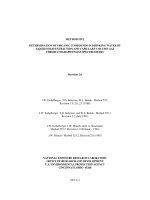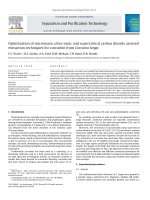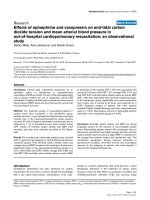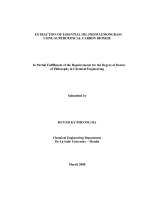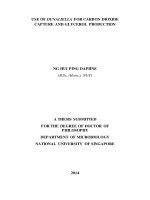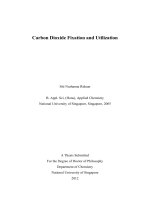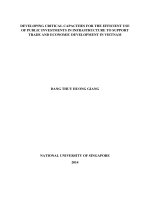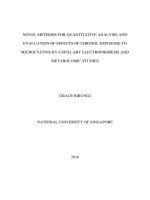Thermodynamics of cholesterol compounds in supercritical carbon dioxide experimental and modeling studies
Bạn đang xem bản rút gọn của tài liệu. Xem và tải ngay bản đầy đủ của tài liệu tại đây (5.75 MB, 280 trang )
THERMODYNAMICS OF CHOLESTEROL COMPOUNDS
IN SUPERCRITICAL CARBON DIOXIDE:
EXPERIMENTAL AND MODELING STUDIES
HUANG ZHEN
NATIONAL UNIVERSITY OF SINGAPORE
2003
THERMODYNAMICS OF CHOLESTEROL COMPOUNDS
IN SUPERCRITICAL CARBON DIOXIDE:
EXPERIMENTAL AND MODELING STUDIES
HUANG ZHEN
(M. ENG., TIANJIN UNIVERISTY)
A THESIS SUBMITTED
FOR THE DEGREE OF DOCTOR OF PHILOSOPHY
DEPARTMENT OF CHEMICAL & BIOMOLECULAR ENGINEERING
NATIONAL UNIVERSITY OF SINGAPORE
2003
Acknowledgements
i
ACKNOWLEDGEMENTS
First of all, I would like to thank my principal advisor Professor Yee C. Chiew
for his invaluable guidance and never-stopping encouragement throughout the span of
my doctoral research at the National University of Singapore. His unmatched
supervision and his spirit and soul as a real scholar, which make my research scholar
experience undoubtedly the most impressive in my life, is highly appreciated. I also
take this opportunity to thank A/P S. Kawi my co-supervisor for his admirable
dedication to my thesis work during the time when Prof. Chiew has been on leave for
years. I also would like to thank A/P W.K. Teo and A/P S.S. Feng for their insightful
suggestions and comments on my PhD study.
I would like to express my heartfelt thanks to the Department technicians:
Samantha, Choon Yen, Mr. Boey, Mdm. Li Xiang, Mdm. Koh, Mdm. Chiang, Mdm.
Tay and Ms. Ng for their pleasing willingness while rendering help for my
experimental work. Special thank must go to Mr. Ng Kim Poi for his great support
during the setup of my experimental apparatus.
I wish to mention my thanks to my senior colleges Wang Xiaoyan and Lu
Weidong, and my junior colleges Zhou Hong, Wu Ning and Wen Hanzhen, as well as
my friends Effendi Widjaja, Chen Shaoping, Liu Xueming, Zhao Lingyun, Peng
Zanguo, etc., for providing a friendly and pleasant environment to live and study at
NUS. Their helps done in the lab are also highly appreciated.
Last, but not least, I would like to show my affectionate regards to my family
members for their love and support while I have been studying overseas. My beloved
mother has always shown me her love and supported me silently with her affection. I
Acknowledgements
ii
feel deeply grateful to my parents-in- law for their kindly caring my child and all the
moral support that they have given me. I am also greatly obliged to my wife and later
my son for their closely accompanying with me and making my stay in Singapore
pleasant, colorful and perfectly satisfactory.
Finally, I want to express my highly appreciation to the National University of
Singapore for funding my pursuit of a PhD degree in the last three and a half years and
supporting my attending AIChE 2000 annual meeting at Los Angels, CA USA.
Tables of Contents
iii
TABLES OF CONTENTS
ACKNOWLEDGEMENTS i
TABLES OF CONTENTS iii
SUMMARY ix
NOMENCLATURE xi
LIST OF FIGURES xvii
LIST OF TABLES xxiii
CHAPTER ONE
Overview 1
1.1 Introduction 1
1.2 Scope of work 4
CHAPTER TWO
Theoretical Background and Literature Review 7
2.1 Introduction 7
2.2 Background on pure supercritical fluid 9
2.2.1 What is the supercritical fluid? 9
2.2.2 Physical properties of supercritical fluids 11
2.2.2.1 Tunable density 11
2.2.2.2 Fast mass transfer rate 12
2.2.2.3 Other merits 15
2.2.3 Choices of supercritical fluids 15
2.2.4 Advantages and disadvantages of CO
2
16
2.3 Solid-supercritical fluid equilibrium 18
2.3.1 Experimental methods 18
Tables of Contents
iv
2.3.2 Solubility characteristics of supercritical solutions 19
2.3.2.1 Typical solid solubility characteristics 19
2.3.2.2 Solid partial molar volume 21
2.3.2.3 Structure of supercritical solutions 23
2.3.3 Solid solubility behavior in pure SCFs 24
2.3.4 Cosolvent effect on the solid solubility behavior in SCFs 26
2.3.5 Cosolute effect on the solid solubility behavior in SCFs 27
2.3.6 Thermodynamic modeling for the supercritical fluids 31
2.4 Cholesterols 35
2.5 Rapid expansion from supercritical solution (RESS) process 37
2.6 Conclusion 41
CHAPTER THREE
Modeling Method 42
3.1 Introduction 42
3.2 Equation of state approach 43
3.2.1 Enhancement factor 43
3.2.2 Cubic equation of state approach 44
3.2.3 Mixing rules 46
3.3 Density-based correlations 48
3.3.1 The
i
yln vs.
ρ
ln or
ρ
linear models 48
3.3.2
Pressure and temperature dependent density models 50
3.4
Summary 52
CHAPTER FOUR
Property Estimation
53
4.1
Introduction 53
Tables of Contents
v
4.2 Vapor pressure 55
4.3
Molar volume 57
4.4
Critical temperature and pressure 58
4.5
Acentric factor 59
4.6
Summary 60
CHAPTER FIVE
Solubility of Cholesterol and its Esters in Pure Supercritical CO
2
66
5.1 Introduction 66
5.2
Experimental methodology 68
5.2.1
Materials 68
5.2.2
Experimental procedure 69
5.2.2.1
Solubility determination 69
5.2.2.2
Non-aqueous reversed phase HPLC 71
5.3
Data correlation 72
5.4
Results and discussion 73
5.4.1
Testing reliability of experimental SCF technique 73
5.4.2
Solubility investigation 74
5.4.3
Modeling results 81
5.4.3.1
Enhancement factor 81
5.4.3.2
Peng-Robinson equation of state 83
5.4.3.3
Partial volume consideration 87
5.4.3.4
Density-based correlations 90
5.5
Conclusion 97
CHAPTER SIX
Solubility of Cholesterol and its Benzoate in SCF CO
2
with Cosolvents 99
Tables of Contents
vi
6.1 Introduction 99
6.2
Experimental setup 100
6.3
Modeling 102
6.4
Results and discussion 104
6.4.1
Cosolvent consideration 104
6.4.2
Solubility enhancement 105
6.4.3
Modeling results by PR EOS approach 111
6.4.4
Modeling results by density-based correlations 116
6.5
Conclusion 122
CHAPTER SEVEN
Behavior of Mixed Cholesteryl Butyrate and Benzoate in Supercritical CO
2
:
Effect of Pressure Induced Structural Transition 123
7.1
Introduction 123
7.2
Experimental section 128
7.2.1
Equipment setup and experimental conditions 128
7.2.2
Bed composition consideration 128
7.2.3
HPLC analysis of collected solid mixture 129
7.2.3.1
HPLC instrumentation 129
7.2.3.2
Preparation of standard solutions 130
7.2.3.3
Chromatographic condition 130
7.2.3.4
Analysis procedure 131
7.2.4
Thermal analysis of mixed cholesteryl esters 133
7.2.4.1
TGA analysis 134
7.2.4.2
Differential scanning calorimetry (DSC) analysis 134
7.2.5 XRD analysis of mixed cholesteryl esters 135
Tables of Contents
vii
7.3 Results and discussion 136
7.3.1
Solubility behavior 136
7.3.1.1
Solubility of mixed cholesteryl esters at 1:1 mass ratio
136
7.3.1.2
Effect of bed composition 140
7.3.2
Phase studies of CBU-CBE mixture 144
7.3.2.1
TGA results 144
7.3.2.2
DSC results 145
7.3.2.3
X-ray diffraction results 156
7.4
Conclusion 161
CHAPTER EIGHT
Modeling the Polar Solid Solubility in SCF CO
2
-Polar Cosolvent Mixture with a
New Peng-Robinson EOS plus Association Model
164
8.1 Introduction 164
8.2
The Peng-Robinson plus association equation of state model 166
8.3
Results and discussion 169
8.3.1 Aspirin-SCF CO
2
-ploar cosolvent systems 170
8.3.2
Naproxen-SCF CO
2
-polar cosolvent systems 174
8.4
Conclusion 178
CHAPTER NINE
Application of the Perturbed Lennard-Jones Chain Equation of State (PLJC
EOS) to Solute Solubility in Supercritical Carbon Dioxide
179
9.1
Introduction 179
9.2
PLJC equation of state for mixtures 183
Tables of Contents
viii
9.3 Results ad discussion 187
9.3.1
Supercritical solvent 187
9.3.2
Binary solid-CO
2
system 189
9.4 Conclusion 199
CHAPTER TEN
Formation of Aspirin and PLGA Particles through Rapid Expansion of
Supercritical Solutions (RESS) Technique
200
10.1 Introduction 200
10.2
Experimental apparatus and procedure 202
10.3
Results and discussion 205
10.3.1
Precipitated aspirin particles 205
10.3.1.1 Effect of nozzle diameter 207
10.3.1.2 Effect of extraction temperature 208
10.3.1.3 Effect of extraction pressure 211
10.3.2
Precipitated PLGA (85:15) particles 212
10.4
Conclusion 217
CHAPTER ELEVEN
Summary and Recommendation
218
11.1
Summary of results and conclusions 218
11.2
Recommendations for further research 222
References 224
Appendix 252
Summary
ix
SUMMARY
Knowledge of equilibrium solubility in supercritical fluid is of great
importance to practical SCF process design. In this work, a continuous-flow system
was set up to measure the solubility of cholesterol and its acetate, butyrate and
benzoate in supercritical CO
2
. Experimentally determined solubility isotherms in pure
supercritical carbon dioxide were obtained over a range of operating conditions from
90 to 270 bar and 308.2 K to 328.2 K. Large solubility differences were observed for
cholesterol and its three esters which can be attributed to the combined effects of
solute polarity and vapor pressure resulting from their distinct chemical structures.
Further investigations on the solubility behavior of cholesterol and cholesteryl
benzoate in supercritical carbon dioxide-polar cosolvent mixtures were conducted at
pressures ranging from 100 to 270 bar and at 318.15 K and 328.15K. The polar
cosolvents employed were methanol and acetone at 3.0 mole% in the supercritical
solvent phase. With the addition of a small quantity of cosolvent, the solubility of
these compounds in supercritical carbon dioxide was enhanced by several folds
depending on the system pressure. Also examined was the solubility behavior of
physically mixed cholesteryl butyrate and cholesteryl benzoate in pure supercritical
CO
2
. A pronounced concurrent solubility decrease, instead of an increase, was
observed for these two esters. This solubility decline is strongly dependent on the bed
composition. The results indicated that these two mixed solutes may have undergone
a phase transition change resulting in the formation of a solid solution at the interfaces
in the presence of supercritical CO
2.
This hypothesis is consistent with our thermal
analysis and X-ray diffraction analysis of binary mixtures of these cholesteryl esters
before and after their exposure to high pressure supercritical carbon dioxide.
Summary
x
Additionally, the formation of ultrafine particles of aspirin and high-molecular-weight
poly-lactic-co-glycolic acid (PLGA) through rapid expansion of supercritical solutions
was investigated over wide ranges of supercritical conditions.
The experimental solubility data were modeled using the equation of state
approach and density-based correlations. To apply the Peng-Robinson cubic equations
of state, the physical properties of cholesterols were estimated through functional
group contribution estimation methods. Model parameters for the systems studied
were obtained by data regression. The modeling results show the solubility behaviors
are well described by the Peng-Robinson equation of state and density based
correlations over the pressure and temperature ranges investigated. Overall, density-
based correlations provide a better quantitative description of the data than the cubic
equations of state. Both approaches perform better for the ternary systems than their
respective binary systems. Besides, a new version of the Peng-Robinson equation
augmented with an association term was developed in our study to describe the
significant cosolvent effect observed in supercritical CO
2
. The correlation performed
on aspirin and naproxen systems shows that the Peng-Robison EOS plus association
model was able to describe the greatly enhanced solubility present in the supercritical
CO
2
-polar cosolvent mixtures very well. Furthermore, a recently developed
molecular-based perturbed Lennard-Jones chain (PLJC) equation model was
employed to model the solubility of 39 solids in pure supercritical CO
2
and very good
agreement between model predictions and data is observed.
Nomenclature
xi
NOMENCLATURE
mixt
A Helmholtz free energy
HSC
mixt
A hard-sphere reference chain term
PERT
mixt
A
Lennard-Jones perturbation chain term
mixt
a molar Helmholtz free energy
ref
mixt
a
reference term
ig
mixt
a ideal gas term
assoc
mixt
a association term
()
ma
0
~
()
mb
2
integral coefficients
a
attractive term in the cubic equations of state
mixt
a ,
m
a attractive term in the cubic equations of state
ii
a attractive parameter of pure component in the cubic equations of state
b repulsive term in the cubic equations of state
ii
b repulsive parameter of pure component in the cubic equations of state
mixt
b ,
m
b repulsive term in the cubic equations of state
3210
,,, cccc constant coefficients of density based correlations
d hard-sphere segment diameter
E
enhancement factor
s
i
f fugacity of solute i
scf
i
f fugacity of solute i in supercritical fluid phase
(
)
s
i
Ls
i
Pf
,
reference liquid fugacity of solute i
()
hs
ijij
dg hard-sphere segment radial distribution function
Nomenclature
xii
A
I
,
B
I
power series integral of density
A
J ,
B
J function of
A
I ,
B
I respectively
k
Boltzmann constant
ij
k binary interaction parameter between molecules i and
j
AB
κ
dimensionless association volume between associated sites
A
and
B
F
K structural factor used to obtain
s
i
P in Grain’s method
i
m
segment number. per chain molecule
i
i
M No. of association sites on molecule
i
, No. of increment
i
1
mm ,
2
mm terms used to obtain
s
i
P in Grain’s method
MW molecular weight
A
N
Avogadro’s number
C
N number of chain molecules
i
n moles of component i , z
P
pressure
c
P critical pressure
s
i
P ,
s
P
sublimation pressure of solid i
c
P∆ pressure increment
R
molar universal gas constant
r
distance between molecular centers
T
temperature
b
T boiling point temperature
c
T critical temperature
m
T melting point temperature
Nomenclature
xiii
r
T reduced temperature, i.e.,
c
TT
rb
T ,
rm
T
reduced temperature used to obtain
s
i
P in Grain’s method
T∆
,
b
T∆ ,
c
T∆ temperature increment
()
ru
potential energy
v molar volume of considered system
c
v
critical molar volume
i
v ,
()
Pyv
i
i
, partial molar volume of solute
i
s
i
v ,
s
v molar volume of solid
i
VS estimated crystal volume of a single molecule (Å
3
/molecule)
i
V volume of increment i (Å
3
)
A
X
mole fraction not bonded at site
A
i
x molar fraction of component i chains, or molecules
i
y mole fraction of solute i in the supercritical fluid phase
z compressibility factor
Z
SCF solvent compressibility factor
b
Z∆ compressibility factor used to obtain
s
i
P in Grain’s method
Greek Characters
ε
,
k/ε
segmental energy
k
AB
/
ε
,
AB
ε
association energy between associated sites
A
and
B
σ segmental size (diameter parameter)
ρ number density of chain segment, SCF solvent density (mol/m
3
)
c
ρ
chain number density
Nomenclature
xiv
ci
ρ
number density of component
i
chain
i
ρ
number density of component
i
chain segment
j
ζ
hard-segment packing fraction, i.e.,
∑
i
j
iicii
dm
ρ
π
6
AB
∆ association strength between site
A
and site
B
s
i
ϕ
the fugacity coefficient of solute
i
at saturation pressure
scf
i
ϕ
the fugacity coefficient of solute i in the supercritical fluid phase
(
)
i
s
ii
yP ,
γ
activity coefficient of solute i at the reference pressure
ω
acentric factor
i
ω
∆ acentric factor increment
i
θ
surface fraction of component
i
i
φ
volume fraction of component i
Subscript and Superscript
A
site
A
assoc association term
c
chain, critical point
cal
calculated value
exp experimental value
i ,
j
, k molecule i ,
j
, k
ref reference term
ig ideal gas
m , mixt mixture system
liq liquid phase
Nomenclature
xv
p
er
t
perturbation term
s
solid phase
scf supercritical fluid phase
Abbreviations
%AARD percentage average absolute deviation
AVDW
augmented van der Waals
BPR
back pressure regulator
CA cholesteryl acetate-
CBE cholesteryl benzoate
CBU
cholesteryl butyrate
CP critical point
CSVDW Carnahan-Starling-van der Waals
D4,2 2,4-dichlorophenoxy acetic acid
DD
T
1,1-bis (4-chlorophenyl)-2,2,2-trichloroethane
DEPC 1,2-dielaidoyl-sn-glycero-3-phosphatidylcholine (di-C18: 1, trans)
DMN−3,2 2,3-dimethylnaphthalene
DSC
differential scanning calorimeter
EOS equation of state
GC gas chromatography
HCB hexachlorobenzene
HPLC high performance liquid chromatography
HSVDW hard sphere van der Waals
di internal diameter
Nomenclature
xvi
NMR nuclear magnetic resonance
PACT
perturbed anisotropic chain theory
PCP pentachlorophenol
PHCT
Perturbed Hard-Chain Theory
PLGA poly-lactic-co-glycolic acid
PLJC perturbed Lennard-Jones chain
PMV
partial molar volume
PVT pressure-volume-temperature
P
R Peng-Robinson
RESS rapid expansion from supercritical solutions
%RMS
percentage root mean square deviation
SAFT statistical associating fluid theory
SAS supercritical antisolvent process
SCF
supercritical fluid
SEM scanning electronic microscopy
SFE supercritical fluid extraction
SRK Soave-Redlich-Kwong
TGA thermogravimetric analyzer
UV ultraviolet
VLE
vapor liquid equilibrium
VOC volatile organic compound
VWD variable wavelength detector
XRD X-ray diffraction
List of Figures
xvii
LIST OF FIGURES
Figure 2.1 Graph showing the supercritical region of CO
2
. 10
Figure 2.2 Variation in density of CO
2
in the vicinity of its critical
point.
12
Figure 2.3 Diffusivity behavior of carbon dioxide in the vicinity of its
critical point (McHugh and Krukonis, 1994).
13
Figure 2.4 Viscosity behavior of CO
2
over a wide pressure and
temperature range (Stephan and Lucas, 1979).
14
Figure 2.5 Solubility behavior of solid naphthalene in supercritical
ethane (Schmitt and Reid, 1986).
20
Figure 2.6 Chemical structures of cholesterol and its three esters. 36
Figure 5.1 Schematic of the experimental apparatus used in measuring
the solid solubility in supercritical CO
2
.
69
Figure 5.2 Effect of carbon dioxide (liquid based) flow rate on the
solubility of cholesterol at 318.15 K, 160 bar
73
Figure 5.3 Comparison of cholesterol solubility in SCF CO
2
75
Figure 5.4 Determination of the sequence of polarity of cholesterol and
its three esters by analyzing mixture of these compounds
with non-aqueous reversed phase HPLC
80
Figure 5.5 Enhancement factors for solids in supercritical CO
2
at 45
o
C 81
Figure 5.6 Enhancement factors for solids in supercritical CO
2
at 35
o
C 82
Figure 5.7 Enhancement factors for solids in supercritical CO
2
at 55
o
C 83
Figure 5.8 Solubility of cholesterol in supercritical CO
2
as a function of
pressure
84
Figure 5.9 Solubility of cholesteryl acetate in supercritical CO
2
as a
function of pressure
85
Figure 5.10 Solubility of cholesteryl butyrate in supercritical CO
2
as a
function of pressure
86
List of Figures
xviii
Figure 5.11 Solubility of cholesteryl benzoate in supercritical CO
2
as a
function of pressure
86
Figure 5.12 Prediction of diluted partial molar volume (PMV) of
cholesterol in SCF CO
2
88
Figure 5.13 Prediction of diluted partial molar volume (PMV) of
cholesteryl acetate in SCF CO
2
88
Figure 5.14 Prediction of diluted partial molar volume (PMV) of
cholesteryl butyrate in SCF CO
2
89
Figure 5.15 Prediction of diluted partial molar volume (PMV) of
cholesteryl benzoate in SCF CO
2
89
Figure 5.16 Solid solubility in pure SCF CO
2
correlated using Chrastil
model
92
Figure 5.17 Solid solubility in pure SCF CO
2
correlated using Kumar
and Johnston model
93
Figure 5.18 Solid solubility in pure SCF CO
2
correlated using Del Valle
and Aguilera model
94
Figure 5.19 Solid solubility in pure SCF CO
2
correlated with proposed
model
95
Figure 5.20
Solid solubility in pure SCF CO
2
correlated using Méndez-
Santiago and Teja model
95
Figure 5.21 Solid solubility in pure SCF CO
2
correlated using Jiang and
Pan model
96
Figure 5.22 Solid solubility in pure SCF CO
2
correlated with
E
-
involved Méndez-Santiago and Teja model
96
Figure 5.23 Solid solubility in pure SCF CO
2
correlated with
E
-
involved Wang and Tavlarides model
97
Figure 6.1 Schematic of the experimental apparatus used in measuring
the solid solubility in the SCF CO
2
–cosolvent mixture
100
Figure 6.2 Effect of flow rate on introduced cosolvent 101
Figure 6.3 Solubility of cholesterol in supercritical CO
2
with acetone
cosolvent
105
List of Figures
xix
Figure 6.4 Cosolvent effect on SCF CO
2
-cholesterol system as a
function of pressure at 318.15K and a cosolvent
concentration of 3.0mol%
107
Figure 6.5 Cosolvent effect on SCF CO
2
-cholesteryl benzoate system
as a function of pressure at a cosolvent concentration of
3.0mol%
108
Figure 6.6 Solubility of cholesteryl benzoate as a function of solvent
mixture density
109
Figure 6.7 Solubility of cholesterol as a function of solvent mixture
density
110
Figure 6.8 PR EOS correlation of solubility of cholesterol in SCF CO
2
with methanol as a cosolvent
112
Figure 6.9 PR EOS correlation of solubility of cholesterol in SCF CO
2
with acetone as a cosolvent
112
Figure 6.10 PR EOS correlation of solubility of cholesteryl benzoate in
SCF CO
2
with a cosolvent at 318.15K
113
Figure 6.11 PR EOS correlation of solubility of cholesteryl benzoate in
SCF CO
2
with a cosolvent at 328.15K
113
Figure 6.12 Chrastil correlation of solute solubility in cosolvent systems 117
Figure 6.13 Kumar and Johnston correlation of solute solubility in
cosolvent systems
118
Figure 6.14
Méndez-Santiago and Teja correlation of solute solubility in
cosolvent systems
118
Figure 6.15 Jiang and Pan correlation of solute solubility in cosolvent
systems
119
Figure 6.16 Del Valle and Aguilera correlation of solute solubility in
cosolvent systems
119
Figure 6.17 Proposed correlation of solute solubility in cosolvent
systems
120
Figure 6.18
E
-involved Méndez-Santiago and Teja correlation of solute
solubility in cosolvent systems
120
Figure 6.19
E
-involved Wang and Tavlaridies correlation of solute
solubility in cosolvent systems
121
List of Figures
xx
Figure 7.1 Work curve for determining mass of collected CBU via
HPLC analysis
131
Figure 7.2 Work curve for determining mass of collected CBE via
HPLC analysis
131
Figure 7.3 Quantitatively analyzing the collected CBE-CBU mixture
with non-aqueous reversed phase HPLC
132
Figure 7.4 Solubility versus pressure isotherms for the CBU-CBE
(1:1)-SCF CO
2
systems
137
Figure 7.5 Effect of bed composition on mutual solubility decrease at
318.15K
142
Figure 7.6 Selectivity of SCF CO
2
for CBU to CBE at 1:1 solid mass
ratio
143
Figure 7.7 Effect of bed composition on selectivities of SCF CO
2
for
CBU to CBE
143
Figure 7.8 TGA curves of cholesterols in Series C at heating rate of
5K/min
144
Figure 7.9 DSC thermo-diagrams of the CBE-CBU system: Series A
(cooling )
148
Figure 7.10 DSC thermo-diagrams of the CBE-CBU system: Series B
(cooling)
149
Figure 7.11 DSC thermo-diagrams of the CBE-CBU system: Series C
(cooling)
149
Figure 7.12 Phase diagram of CBE-CBU binary mixture (obtained from
cooling T profiles)
150
Figure 7.13 DSC thermo-diagrams of the CBE-CBU system: Series A
(heating)
150
Figure 7.14 DSC thermo-diagrams of the CBE-CBU system: Series B
(heating)
151
Figure 7.15 DSC thermo-diagrams of the CBE-CBU system: Series C
(heating)
153
Figure 7.16 Phase diagram of CBE-CBU binary mixture (obtained from
heating T profiles of Series C)
154
Figure 7.17 Phase diagram of CBE-CBU binary mixture (obtained from
heating T profiles of Series A)
154
List of Figures
xxi
Figure 7.18 Phase diagram of CBE-CBU binary mixture (obtained from
heating T profiles of Series B)
155
Figure 7.19 X-ray powder diffraction patterns of CBU/CBE solid
mixture prepared by the melting method (Series C) at
different mass ratios
157
Figure 7.20 X-ray powder diffraction patterns of physically mixed
CBU/CBE samples at different mass ratios (Series A)
158
Figure 7.21 X-ray powder diffraction patterns of Series B samples
(physically mixed CBU/CBE solid samples subjected to
high pressure via the SCF CO
2
process) at different mass
ratios
159
Figure 7.22 X-ray powder diffraction patterns of the CBE-CBU system
with 67 mass% CBE
161
Figure 8.1 Correlation of aspirin solubility in SCF CO
2
with methanol
as a cosolvent
172
Figure 8.2 Correlation of aspirin solubility in SCF CO
2
with ethanol as
a cosolvent
173
Figure 8.3 Correlation of aspirin solubility in SCF CO
2
with acetone as
a cosolvent
173
Figure 8.4 Solubility of the naproxen-SCF CO
2
+methanol systems
using the PR EOS plus association model
175
Figure 8.5 Solubility of the naproxen-SCF CO
2
+2-propanol systems
using the PR EOS plus association model
175
Figure 9.1 Supercritical fluid behavior of CO
2
and correlation with
PLJC EOS model
188
Figure 9.2 Experimental solubility of cholesteryl acetate in supercritical
CO
2
and correlation with PLJC EOS model
195
Figure 9.3 Experimental solubility of hexamethylbenzene in
supercritical CO
2
and correlation with PLJC EOS model
196
Figure 9.4 Experimental solubility of cholesteryl butyrate in
supercritical CO
2
and correlation with PLJC EOS model
196
Figure 9.5 Experimental solubility of progesterone in supercritical CO
2
and correlation with PLJC EOS model
197
Figure 9.6 Experimental solubility of phenanthrene in supercritical CO
2
and correlation with PLJC EOS model
197
List of Figures
xxii
Figure 9.7 Experimental solubility of 1,10-decanediol in supercritical
CO
2
and correlation with PLJC EOS model
198
Figure 9.8 Experimental solubility of pyrene in supercritical CO
2
and
correlation with PLJC EOS model
198
Figure 10.1 Schematic illustration of the RESS experimental apparatus 203
Figure 10.2 SEM photograph of aspirin particles via RESS process at
extr
P
=200bar,
extr
T
=45
o
C and Nozzle i.d.=0.04mm and L
=0.2mm (Domingo et al., 1997)
206
Figure 10.3 Optical photomicrograph of commercial aspirin as received 206
Figure 10.4 Optical photomicrograph of precipitated aspirin from
supercritical CO
2
via RESS processing at
extr
P =160 bar,
extr
T =70
o
C and Nozzle i.d.=0.06mm
208
Figure 10.5 Optical photomicrograph of precipitated aspirin from
supercritical CO
2
via RESS processing at
extr
P =160bar,
extr
T
=50
o
C, Nozzle i.d.=0.35mm
208
Figure 10.6 SEM photographs of precipitated aspirin from supercritical
CO
2
via RESS processing at
extr
P
=160bar,
extr
T
=70
o
C and
Nozzle i.d.=0.35mm
209
Figure 10.7 SEM photograph of precipitated aspirin from supercritical
CO
2
by RESS processing at
extr
P =200bar,
extr
T =70
o
C and
Nozzle i.d.=0.35mm
211
Figure 10.8 SEM photographs of precipitated aspirin collected at
extr
P =180bar,
extr
T =70
o
C and Nozzle i.d.=0.35mm.
212
Figure 10.9 SEM photograph of precipitated PLGA (85:15) from
supercritical CO
2
by RESS processing at
extr
P =160bar,
extr
T =40
o
C and Nozzle i.d.=0.35mm
214
Figure 10.10 SEM photographs of precipitated PLGA (85:15) from
supercritical CO
2
by RESS processing at
extr
P =180bar,
extr
T
=40
o
C and Nozzle i.d.=0.35mm
215
Figure 10.11 SEM photograph of precipitated PLGA (85:15) from
supercritical CO
2
by RESS processing at
extr
P =180 bar,
extr
T = 40
o
C and Nozzle i.d.= 0.35mm
216
List of Tables
xxiii
LIST OF TABLES
Table 2.1 Physical data of gases, SCFs and liquids states 10
Table 2.2 Physical properties of candidate SCFs 16
Table 3.1 Constants for three cubic equations of state 45
Table 4.1 Estimated solid vapor pressures of cholesterols obtained by
Grain’s method
61
Table 4.2 Estimated molar volumes of cholesterols obtained by
Immirzi and Perini method
61
Table 4.3 Estimated critical temperatures of cholesterols obtained by
the Joback modification of Lydersen’s method
62
Table 4.4 Estimated critical pressures of cholesterols obtained by
Klincewicz and Reid method
63
Table 4.5 Estimated acentric factors of cholesterols obtained using
Han and Peng’s method
64
Table 4.6 Required physical properties of all compounds used 65
Table 5.1 Sources and purity of all compounds used 68
Table 5.2 Solubility of cholesterol in pure SCF CO
2
(mole fraction) 75
Table 5.3 Solubility of cholesteryl acetate in pure SCF CO
2
(mole
fraction)
77
Table 5.4 Solubility of cholesteryl butyrate in pure SCF CO
2
(mole
fraction)
77
Table 5.5 Solubility of cholesteryl benzoate in pure SCF CO
2
(mole
fraction)
78
Table 5.6
Regressed
12
k between CO
2
and cholesterol obtained using
PR EOS
85
Table 5.7 Regressed interaction parameters between CO
2
and
cholesteryl esters
87
